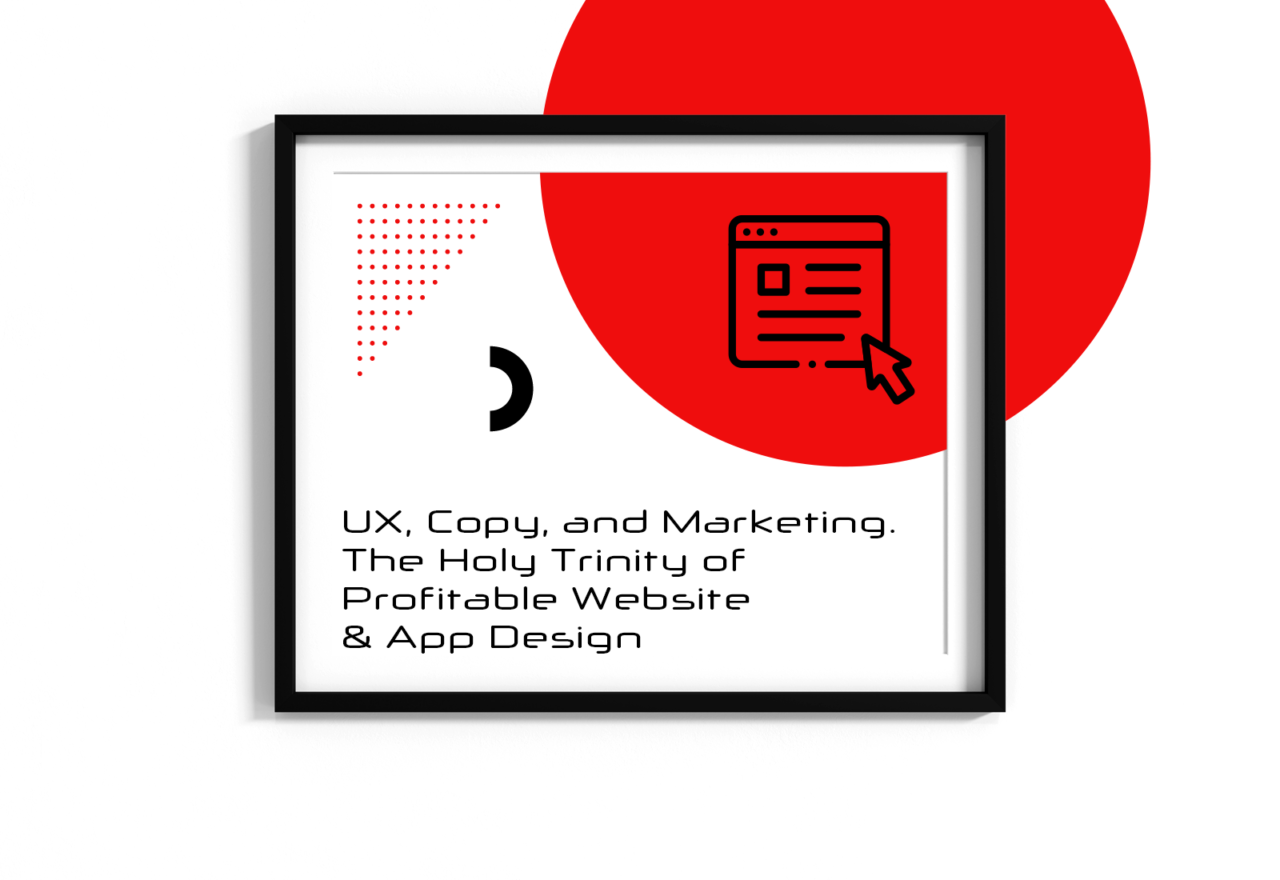In today’s digital landscape, the collaboration between marketers, copywriters, and User Experience (UX) designers has become pivotal in crafting successful products and services. This synergy ensures that the user experience is not only user-centric but also aligns with business goals, ultimately leading to a more successful and satisfying product or service for both customers and organizations. By recognizing the integral role of marketers in UX design, businesses can create a competitive advantage, driving growth and fostering strong user relationships.
The lion’s share of our projects has in its scope the revamping or full-scale creation of sites from scratch. That’s why the teams working on the projects consist of an array of specialists.
Table of Contents:
- How are UX and Copy related?
- What is the marketer’s role in the UX process?
- How to make your website or app user-friendly for higher CTR and ROAS.
- 3 Tips to Achieve Effective Collaboration.
- Tools for Your Team – Integrating UX and Marketing Workflow.
How are UX and Copy related?
The relationship between User Experience (UX) and good copywriting is extremely close and important, as both are key elements of effective communication and design of products and services. Here’s how the two areas interrelate.
First of all, the clarity and comprehensibility of the text. Good copywriting is about creating content that is clear, understandable, and accessible to users. This provides a better user experience because users shouldn’t have to make an effort to understand what we want to convey. Comprehensible copywriting helps eliminate the language barrier, which is crucial, especially if the product or service is available in different markets and to different target groups.
Next, we need to motivate action. Good copywriting can effectively encourage users to take specific actions, such as clicking a button, signing up for a newsletter, purchasing a product, or using a service. This is also a key element of UX design because UX is not just about creating interfaces, but also about directing users to desired actions.
Don’t forget about creating emotions and connections! Copywriting is used to build emotional connections between the user and the brand or product. Creating stories, using appropriate tones and writing styles, and communicating the value and benefits of a product or service can influence how a user perceives and engages with a product. This is extremely important for building user loyalty.
Moreover, both UX and copywriting require consistent communication at different stages of using a product or service. When content is consistent with the interface, the user can more easily navigate and understand what is going on. Lack of consistency can lead to user confusion and frustration.
Last but not least – the neverending story of testing and optimization. The UX and copywriting can be improved through testing and data analysis. You can test different text and message variations to find out which works best in terms of conversion and user satisfaction. In this way, content can be tailored to users’ needs, resulting in a better experience (and more conversions).
In conclusion, good copywriting is an integral element of successful UX design, as it affects users’ comprehensibility, engagement, motivation, and emotion. Collaboration between copywriters and UX designers will lead to more effective and user-friendly products and services.

What is the marketer’s role in the UX process?
Marketers play a crucial role in UX design, as we contribute to various aspects of the user’s journey and the overall success of a product or service. Here are several key roles we play in the process:
1) User Research.
Marketers conduct market research and customer analysis, providing valuable insights into user behavior, needs, preferences, and pain points. This data informs UX designers about the target audience and helps shape the user personas and user stories that guide the design process.
2) Defining Goals.
We help define business and marketing goals, which should align with the user experience objectives. These goals provide a clear direction for UX designers to ensure that the design supports and contributes to achieving those objectives.
3) Content & Communication Strategy.
Content is King. Marketers and Copywriters are responsible for creating and managing the content that users interact with. This includes text, images, videos, and other media. A well-planned content strategy is essential for a positive user experience, and marketers play a central role in developing this strategy.
The messaging and communication strategies are integrated into the user interface. Effective messaging not only informs users but also influences their behavior, making it a critical part of the user experience. Throughout the process, it is important to maintain brand consistency, as it is essential for user trust and recognition. Marketers ensure that the visual design, tone of voice, and messaging align with the brand identity throughout the user journey.
4) User Engagement, Acquisition and Retention.
We need to engage users through various channels, including email marketing, social media, and advertising. Our efforts can drive traffic to a product or service, making it necessary to ensure that the user experience aligns with the expectations set by marketing campaigns. We are also responsible for acquiring new users and retaining existing ones. The user experience directly influences user retention, so marketers ought to collaborate with UX designers to create experiences that encourage users to stay and continue engaging with the product or service.
5) A/B Testing and Conversion Rate Optimization.
The A/B testing is no novelty. This one and other data-driven techniques lead to optimizing various aspects of a product or service, such as landing pages, CTAs, and conversion funnels. These optimizations directly impact the user experience and require collaboration with UX designers to implement changes effectively.
Marketers gather feedback from users through surveys, reviews, and customer support interactions. This feedback is also invaluable for UX designers to identify areas for improvement and make iterative design changes.
The constant work of improving conversion rates often involves optimizing the user experience on key conversion pages or flows. UX designers play a critical role in making these optimizations while maintaining a user-centric approach.
In summary, marketers and UX designers should collaborate closely to create a cohesive and effective user experience that meets both business objectives and user needs. Their combined efforts ensure that the product or service not only attracts users but also provides a positive and satisfying experience, ultimately leading to business success.
Marketers bring a wealth of knowledge about user behavior, market trends, and business objectives, which directly informs the UX design process. From user research and defining goals to content strategy and messaging, marketers play multifaceted roles in ensuring that the user experience aligns with both user needs and organizational objectives. They contribute to the development of user personas, based on their comprehensive customer analysis, and help shape the content strategy, which is a cornerstone of an effective UX.

How to make your website or app user-friendly for higher Conversion Rates and ROAS
Designing a website or app that prioritizes User Experience (UX) to improve Return on Ad Spend (ROAS) involves several key principles and strategies. Here’s a little step-by-step guide to help you achieve better results through effective UX design:
Start by conducting thorough user research to gain insights into your target audience’s preferences, behaviors, and pain points. Develop user personas to better understand their needs and motivations, which will inform your design decisions.
Define clear and measurable objectives for your website or app. Identify the specific actions you want users to take, such as signing up, making a purchase, or clicking on an ad. These goals should align with your advertising and business objectives.
- Create an intuitive and user-friendly navigation structure. Ensure that users can easily find what they’re looking for. Use clear and concise labels for menus and navigation links, and implement a logical information architecture. Copywriters should ensure that content is engaging, informative, and relevant to the target audience. High-quality content can increase user engagement and encourage users to explore further.
- Remember! Slow-loading pages can lead to high bounce rates. Optimize your website or app for speed by minimizing image sizes, leveraging browser caching, and using content delivery networks (CDNs). Mobile optimization is crucial, as well, given the increasing number of users on mobile devices. Ensure your design is responsive, adapting seamlessly to different screen sizes and devices. Mobile users should have a comparable and smooth experience to desktop users.
- Use high-quality images and visuals that resonate with your target audience. Visuals should enhance the user experience and support your messaging. Avoid clutter and distractions that can divert users’ attention from your primary CTA (Call to Action). Place clear and prominent Call to Action buttons strategically throughout your website or app. Use action-oriented language that communicates the benefit of clicking. Test different CTA designs and placements to determine what works best.
- Eliminate any barriers that might deter users from taking the desired actions. This includes simplifying forms, reducing the number of steps in a process, and offering guest checkout options for e-commerce sites. Build trust by displaying trust signals such as security badges, privacy policies, and customer reviews. Users are more likely to convert when they feel secure and confident in your platform.
- Use analytics tools to track user behavior, conversion rates, and the performance of your advertising campaigns. Regularly analyze this data to identify areas for improvement and adjust your UX design accordingly.
By following these UX design principles and continually refining your website or app based on user feedback and data-driven insights, you can create a user-centric experience that leads to higher CTR and ROAS, ultimately driving the success of digital marketing efforts.
3 Tips to Achieve Effective Collaboration
Effective collaboration between marketers, UX designers, and copywriters is essential to create a seamless and persuasive user experience. Here are the top 3 tips for marketers when it comes to UX and copy.
1. Alignment of Message and Design:
The visual elements, tone of voice, and content should work harmoniously to convey a clear and consistent message. Collaborate closely with UX designers to ensure that the design elements support the intended message. For example, if your copy highlights the benefits of a product, make sure the design highlights those benefits through visuals and layout.
2. User-Centered Language:
Use user-centered language in your copywriting. Focus on addressing the needs, desires, and pain points of your target audience. Speak directly to their concerns and aspirations to create a more relatable and engaging experience. Tailor your copy to resonate with their unique characteristics and motivations.
3. Clear and Actionable CTAs:
Craft clear and actionable CTA copy that guides users toward the desired action. Use action-oriented words that convey a sense of urgency and benefit. Collaborate with UX designers to ensure that the placement, size, and design of CTAs are prominent and attention-grabbing. Make sure users can easily identify and engage with the CTAs throughout their journey on the website or app.
Follow these tips to enhance the synergy between UX and copy, creating a user experience that not only engages and informs but also motivates users to take action, ultimately driving better results for marketing campaigns and conversions.
Tools for Your Team – Integrating UX and Marketing Workflow
Giving good bits of advice is fine, but sharing useful tools is even better! We’re not going to leave You with nothing. We understand that integrating UX and marketing workflows is crucial for creating a cohesive and effective user experience that aligns with marketing goals. Several tools can help streamline collaboration between teams. Take a look at some of the best tools for this purpose:

Project Management Tools:
- Trello/ ClickUp – user-friendly project management tools that use boards, lists, and cards to organize tasks. It’s great for tracking project progress, assigning responsibilities, and setting deadlines for UX and marketing projects.
- Asana – a versatile project management tool that helps teams plan, organize, and manage tasks, projects, and campaigns. It offers customizable workflows and task dependencies, making it suitable for complex projects.
Design Tools:
- Figma – a cloud-based design and prototyping tool that allows UX designers to collaborate in real-time. Marketers can also review designs and provide feedback directly within the platform.
- InVision – a prototyping tool that enables UX designers to create interactive prototypes and share them with stakeholders. Marketers can use it to review and comment on designs, improving communication between teams.
- AdobeXD – used to create interactive prototypes of mobile applications and websites. This tool is dedicated to UX and UI designers, and graphic designers.
User Research and Testing Tools
- UserTesting – a platform that allows you to conduct remote user testing and gather valuable feedback on your website or app. Marketers can use it to understand user behavior and preferences.
- Optimal Workshop – this suite of tools helps UX designers and marketers conduct user research, including card sorting, tree testing, and first-click testing, to optimize information architecture and content.
Analytics and Data Visualization Tools:
- (Old but gold) Google Analytics – provides valuable insights into user behavior and website performance. Marketers and UX professionals can use it to analyze data and make data-driven decisions.
- Tableau – a powerful data visualization tool that helps teams create interactive dashboards and reports, enabling better data-driven decisions and insights sharing.
Marketing Automation Platforms:
- HubSpot – an all-in-one marketing automation platform that includes email marketing, content management, and CRM integration. It helps align marketing efforts with user-centric content strategies.
- Zapier – an online platform that helps automate your workflow by connecting the applications and services you use.
- EngageBay – a marketing automation platform software that comes with a wide range of features including email marketing, social media management, and website chat.
The choice of tools is broad, and it’s really up to you and your team which one you prefer.
Selecting the right combination of tools depends on your team’s specific needs, budget, and existing technology stack. The key is to choose tools that facilitate seamless communication, collaboration, and data sharing between UX and marketing teams, ensuring a unified approach to enhancing the user experience and achieving marketing objectives.






